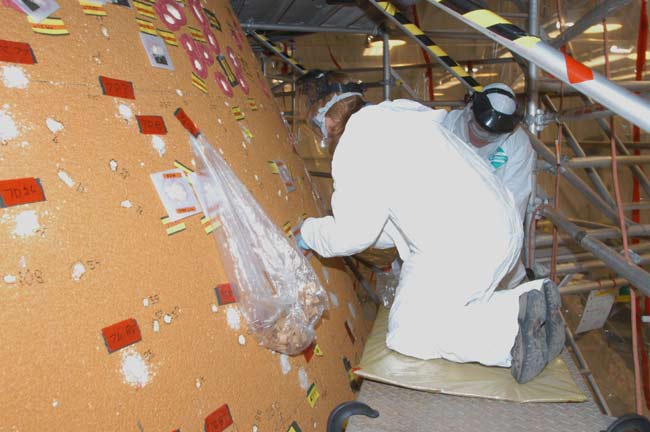Fuel Tank Repairs Enter Second Phase for Shuttle Atlantis

CAPE CANAVERAL - NASA setout Tuesday on a second phase of repairs to shuttle Atlantis' hail-batteredexternal tank, work that will determine whether the agency can resumeInternational Space Station construction as planned in early June.
Normally done with roboticsin the factory, the unprecedentedwork requires technicians to spray an aerodynamically smooth layer ofthermal insulation on the curved portion near the top of the bullet-shapedtank.
Engineers built mock-upsand developed step-by-step procedures to prepare for the high-precisionrepairs, and technicians practiced manual sprays. NASA has never flown a tankrepaired with this technique.
"There's a lot ofconfidence that everything is going to go smoothly," said June Malone, aspokeswoman for NASA's Marshall Space Flight Center in Huntsville, Ala.
The work is critical toNASA's plansto launch Atlantis and seven astronauts around June 8 on a mission todeliver a new 17.5-ton truss segment to the international outpost.
The launch had beenscheduled for March 15 but was postponed when the shuttle's 15-story tank sustainedserious damage during a Feb. 26 hailstorm.
Technicians already havefixed more than 2,100 of some 2,600 dents, divots and gouges in foam insulationcovering the central and lower portions of the tank.
Breaking space news, the latest updates on rocket launches, skywatching events and more!
NASA also is inspecting theorbiter's main propulsion system propellant lines in an effort to spot anycontamination that could trigger an engine failure in flight.
The inspections follow thediscovery of four small pieces of silicon rubber within one of the three mainengines that flew on a shuttle last December. Debris in a propellant line coulddegrade engine performance or, in a worst case, lead to a catastrophic failurein flight.
Engineers are usingsnake-like devices tipped with cameras.
The tank repairs and engineinspections are scheduled to be complete before the shuttle returns to launchpad 39A around May 15. About 22 days of routine launch preparations arerequired at the pad, so the schedule for a June 8 flight is tight.
Published under license from FLORIDATODAY. Copyright 2007 FLORIDA TODAY. No portion of this materialmay be reproduced in any way without the written consent of FLORIDA TODAY.
- STS-117 Power Play: Atlantis Shuttle Crew to Deliver ISS Solar Wings
- Complete Shuttle Mission Coverage
- All About the Space Shuttle
Todd Halvoron is a veteran aerospace journalist based in Titusville, Florida who covered NASA and the U.S. space program for 27 years with Florida Today. His coverage for Florida Today also appeared in USA Today, Space.com and 80 other newspapers across the United States. Todd earned a bachelor's degree in English literature, journalism and fiction from the University of Cincinnati and also served as Florida Today's Kennedy Space Center Bureau Chief during his tenure at Florida Today. Halvorson has been an independent aerospace journalist since 2013.
